Geological background and Economic Minerals in Sri Lanka
View(s):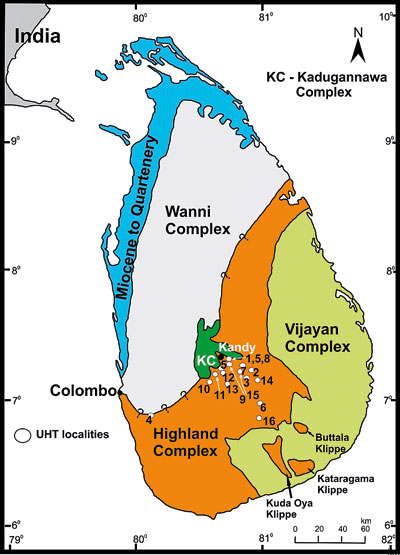
Geological Map of Sri Lanka
Sri Lanka, formerly Ceylon, island country lying in the Indian Ocean and separated from peninsular India by the Palk Strait. It is located between latitudes 5°55′ and 9°51′ N and longitudes 79°41′ and 81°53′ E and has a maximum length of 268 miles (432 km) and a maximum width of 139 miles (224 km). When consider about the geological background of Sri Lanka, It has been divided to four main geological categories. These are,
1. Highland complex
2. Vijayana Complex
3. Wanni Complex
4. Kadugannawa Complex.
The Highland Complex (HC)
This complex is composed of inter-banded metamorphic rocks, broad; running across the center of the island from southwest to northeast.
Included rocks: – Granulitefaces rocks Charnokiticgneiss, Marble, Quartzite, Quartzofeldspathic gneiss
Wanni Complex (WC)
No clear boundary between HC and WC in this group of rocks the most common rock types are gneisses of hornblende and biotite.
Included rocks: – Hornblende bearing gneiss, Pink granite
Vijayan Complex (VC)
In the Vijayan region, a low range of low pressure, low temperature, hot springs, alloys, hot springs, whole mineral salts, magnetite, zirconite vane quarts, Cu-magnetite are well-established. Orangal and biotite can be identified in low-grade variables.
Kadugannawa Complex (KC)
This complex is originated due to high temperatures and pressures associated with the process of metamorphism and commonly no agreement on the origin of these rocks.
Included rocks: -Biotitic-hornblende gneiss and Amphibolites
Rocks and Minerals
Firstly when consider about minerals, rocks are mixtures, or aggregates, of different minerals. They are divided into three categories based on how different rocks are formed: Igneous rocks, sedimentary rocks, and metamorphic rocks.
Igneous rocks : A formed when hot magma from volcanoes is rapidly cooled, either by hitting underground air pockets or by flowing from the mouth of a volcano as lava. Granite, obsidian, and pumice are all common examples of igneous rocks.
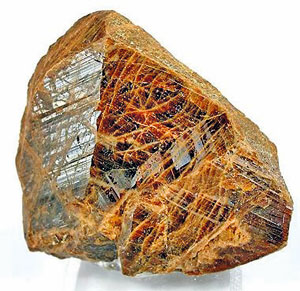
Monazite
Sedimentary rocks: A formed by layers of earth being mixed and compressed together for extended periods of time. Common examples of these rocks are limestone, sandstone, and shale.
Metamorphic rocks : A combination of rock types, usually compressed together by high pressure, which tends to give them a harder, grainy texture than the other two types. Schist, slate, and gneiss (pronounced like ‘nice’) are metamorphic rocks.
Similarly, minerals are naturally-occurring, solid substances composed of chemical elements. This means that minerals, ranging from salt to rubies, are made up from the elements that appear on a periodic table. They are inorganic, not living or made up of living things. Minerals form a crystalline structure which gives rocks their ‘rough’ texture. The Geological Survey and Mines Bureau (GSMB) in Sri Lanka is one of the responsible authorities for economic minerals in Sri Lanka. GSMB evaluates the extension of the mineral reserve and conduct research on the quality of the resource. Two sub sections are responsible by GSMB such as economic minerals and economic rocks
Economic minerals are classified into 4 major groups such as;
1. Energy minerals
2. Ferrous and ferroalloy group
3. Non-ferrous group
4. Non-metallic group
Energy minerals
Uranium, Uranite, Thorite (the silicate of thorium), Thorianite (the oxide of thorium) and monazite have been found in Sri Lanka. Uranium and thorium minerals are mostly found in detrital deposits in Kalaoya area and Ratnapura, Pelmadulla areas respectively. Monozite is found as placer deposits around Induruwa and Polkatuwa area near Beruwala along the southern beach, heavy mineral concentrates in gem bearing sediments in Ratnapura as well as in Pulmoddai as beach sands.
Ferrous and ferroalloy group
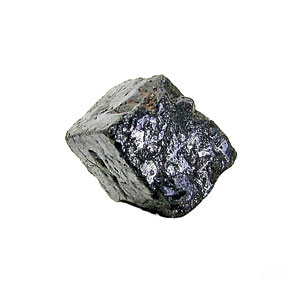
Thorianite
Most common ferrous and ferroalloy minerals found in Sri Lanka are magnetite, hematite and iron oxides. This deposit is considered as surface as well as subsurface reserve. Recently found magnetite-hematite deposit at Wellawaya is one of the best ferrous and ferroalloy mineral deposits we have in Sri Lanka. Several small magnetite reserves are found in Wilagedara and Panirendawa around Sandalanka and Chilaw respectively. These are mostly surface deposits.
Seruwawila Cu-Magnetite The copper-magnetite deposit at Seruwawila also important. This was discovered by the Department of Geological Survey in 1971. Magnetite and Sulphide massive sections can be found in here. Those are about 1-10 m in thickness. About 40% of the reserve is considered as iron while 2% is estimated as copper. However, since this reserve is located underground, the extraction cost would be very high. Ferroalloy Serpentine deposit is rich in Nickel, Cobolt, Manganese and Chromium. Most popular serpentine deposits are found at Ussangoda and Udawalawe.
Non-ferrous minerals
Pulmoddai beach sand deposit is the most important non-ferrous mineral reserve in Sri Lanka to date. It contains minerals which consist of one of the most expensive and important metals in the world that is titanium. Ilmanite (FeTiO2) and rutile (TiO2) found in enormous concentrations in the Pulmoddai beach sand deposit. This deposit extends from Nilaveli to Kokilai lagoon mouth. The distance is about 7.5km. The average width of the sand deposit is about 60 m. Several sand types are found in here; ilmanite (70-72%), zircon (8-10%), rutile (8%), silimanite (1%) as well as monazite (0.3%). Geological explorations have estimated the total reserve is about 4 million tons of sand in Pulmoddai deposit while three closer deposits consist of another 7 million tones more. Exporting sand from this deposit started on 1959. Ilmanite and rutile in this deposit are rich in TiO2. Experiments have shown that TiO2 concentration of ilmanite is about 53% while that of rutile is about 95%.
Nonmetallic minerals
Sri Lanka is rich in nonmetallic minerals such as Graphite , Vein quartz , Apatite , Dolomite ,Feldspar, Gems , Mica ,Clays , Kaolinite , Sands , Garnet sand ,Silica sand
Graphite
The use of graphite in Sri Lanka has a long history, from 1675. Sri Lankan graphite is very popular all over the world for its high purity. There are two major mines for graphite, Kahatagaha-Kolongaha and Bogala. The largest mine is Kahatagaha-Kolongaha close to Matale-Kurunegala road. This is deeper than 650 m.
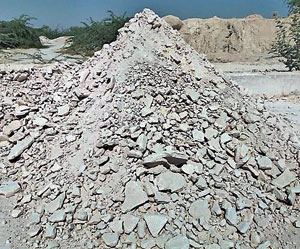
Kaolinite
Quartz and Feldspar
Quartz sand from Marawila-Naththandiya deposits is used for bottle industry while quartzite pieces from Galaha and Wellawaya are exported directly Metasediments aged 2000 million years Feldspar is used as a raw material for ceramic and porcelain industries. The main feldspar mine is located at Rattota, Matale.
Apatite
One of our best economic mineral reserves is the apatite rock phosphate at Eppawala. It reserves extents over 7 km2 and about 125 m deep from the surface. This has been proven by deep drilling. It is estimated that the reserve consist of 60 million tons of apatite. Apatite is being used to produce phosphate fertilizer. However, enrichment of iron and less soluble tricalcium phosphate in the reserve, fertilizer shows low solubility. Therefore the fertilizer from this reserve, triple super phosphate, is used for long term crops.
Feldspar, mica and dolomite Feldspar, mica and dolomite are used for domestic industries. Feldspar is used as a raw material for ceramic and porcelain industries. The main feldspar mine is located at Rattota, Matale. Mica mining and exporting has a long history as well. It dates back as far as 1896. Dolomite is utilized as a fertilizer in tea cultivation also as a substitute for lime from corals. Largest dolomite mine is located at Digana, while several small scales mines are located near Badulla.
Clay
Three main types of clays are used to produce domestic as well as export goods; kaolinite, ball clay and brick clay. Borelasgamuwa and Meetiyagoda kaolinite deposits are the two main deposits for kaolinite in Sri Lanka. Weathering of quartz-feldspar-biotite gneiss (commonly known as kalu gal in Sinhalese) results is kaolinite. The depth of kaolinite clay deposit at Borelasgamuwa is about 10 m but distributed throughout a large area and consists of best quality clay. Although Meetiyagoda deposit is about 30 m deep it has many impurities. Yellow, red and blue color ball clay is found in hill country. These are being used to make casts and used as refractory material because of their strength and high plasticity. Brick clay is found in most of the river valleys and they are used to produce bricks and tiles.
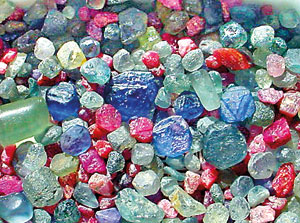
Gems
Gems
The history of gems in Sri Lanka dates back to more than 2500 years. According to gemologists Sri Lanka is the country with the highest density of gem varieties. All minerals are not gems and all gems are not minerals either. Some organic materials are considered as gems such as pearl and amber. Only inorganic materials are considered as minerals. We are going to talk about the gems that are minerals. Gem deposits in Sri Lanka can be categorized into 3 main groups. These are residual deposits – Okkampiiya, Elluvial deposits – Elahera,and Alluvial deposits – Ratnapura
Reference:
1. Prof: kapila dahanayaka, university of peradeniya Origin of srilankan geology.
2. (P.G cooray), An Introduction to the geology of srilanka.
3. Sarath jayathilaka, Geology and mineral resources of srilanka.
4. www.ifs.ac.lk/pdf/lecturer/geog/economic/20geology/20cf/20srilanka pdf.
- K. P. K. Sandamali


